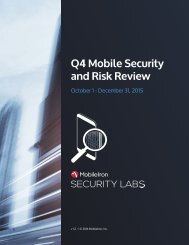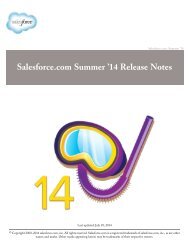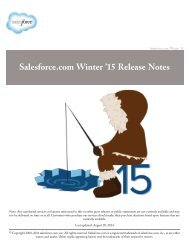salesforce_security_impl_guide
salesforce_security_impl_guide
salesforce_security_impl_guide
You also want an ePaper? Increase the reach of your titles
YUMPU automatically turns print PDFs into web optimized ePapers that Google loves.
Securing and Sharing Data<br />
Creating Account Territory Sharing Rules<br />
Access Setting<br />
Private<br />
(available for associated contacts, opportunities, and cases only)<br />
Read Only<br />
Read/Write<br />
Description<br />
Users can’t view or update records, unless access is granted<br />
outside of this sharing rule.<br />
Users can view, but not update, records.<br />
Users can view and update records.<br />
11. Click Save.<br />
Note: Contact Access is not available when the organization-wide default for contacts is set to Controlled by Parent.<br />
Creating Account Territory Sharing Rules<br />
Account territory sharing rules are based on territory assignment. You can define up to 300 account<br />
territory sharing rules.<br />
1. If you plan to include public groups in your sharing rule, confirm that the appropriate groups<br />
have been created.<br />
2. From Setup, click Security Controls > Sharing Settings.<br />
3. In the Account Territory Sharing Rules related list, click New.<br />
4. Enter the Label Name and Rule Name. The Label is the sharing rule label as it appears on the<br />
user interface. The Rule Name is a unique name used by the API and managed packages.<br />
5. Enter the Description. This field describes the sharing rule. It is optional and can contain up to<br />
1000 characters.<br />
6. In the Accounts in Territory line, select Territories or Territories and Subordinates from the first<br />
drop-down list and a territory from the second drop-down list.<br />
EDITIONS<br />
Available in:<br />
• Enterprise<br />
• Performance<br />
• Unlimited<br />
• Developer<br />
USER PERMISSIONS<br />
To create sharing rules:<br />
• “Manage Sharing”<br />
7. In the Share with line, specify the users who should have access to the data: select a category from the first drop-down list and<br />
a set of users from the second drop-down list or lookup field.<br />
8. Select a setting for Default Account, Contract and Asset Access .<br />
9. In the remaining fields, select the access setting for the records associated with the shared account territories.<br />
Access Setting<br />
Private<br />
(available for associated contacts, opportunities, and cases only)<br />
Read Only<br />
Read/Write<br />
Description<br />
Users can’t view or update records, unless access is granted<br />
outside of this sharing rule.<br />
Users can view, but not update, records.<br />
Users can view and update records.<br />
10. Click Save.<br />
Note: Contact Access is not available when the organization-wide default for contacts is set to Controlled by Parent.<br />
53






